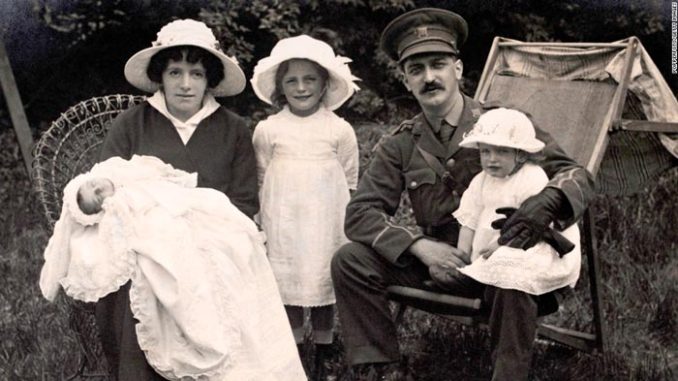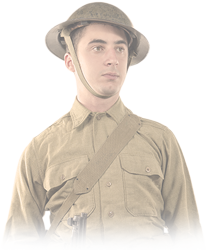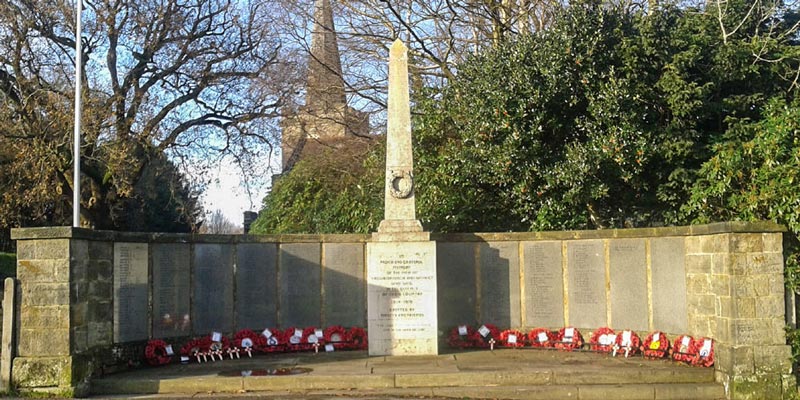
 What did your Great-Grandad, Great -Uncle or Great-Great Grandad do in World War One? Was he a soldier on the Western or Eastern Fronts? Perhaps he was in the Navy, protecting convoys and defending our shores? Maybe he was in a reserved occupation and was vital to the work on the homefront? What about your Great-Grandma or Great Aunt? What did she do? Maybe she was a qualified nurse serving on medical ships, or in military hospitals looking after the sick and wounded? Maybe she was in the Voluntary Aid Detachment (VAD) working in a VAD Hospital in Britain? Maybe she was a Land Girl involved in feeding the nation, or maybe she was a munitionette risking her life making much needed ammunition for the Front?
What did your Great-Grandad, Great -Uncle or Great-Great Grandad do in World War One? Was he a soldier on the Western or Eastern Fronts? Perhaps he was in the Navy, protecting convoys and defending our shores? Maybe he was in a reserved occupation and was vital to the work on the homefront? What about your Great-Grandma or Great Aunt? What did she do? Maybe she was a qualified nurse serving on medical ships, or in military hospitals looking after the sick and wounded? Maybe she was in the Voluntary Aid Detachment (VAD) working in a VAD Hospital in Britain? Maybe she was a Land Girl involved in feeding the nation, or maybe she was a munitionette risking her life making much needed ammunition for the Front?
Researching your family tree can be a very rewarding and enjoyable activity. You can discover fascinating stories about your ancestors and how they lived, and no doubt a few surprises along the way! Sometimes though it can be very frustrating, as not all records survive, for example many of the First World War Records were destroyed by bombing during the Second World War. Other problems include spelling errors on forms, errors when records were transcribed into digital formats and even relatives lying on official forms! However this shouldn’t put you off, as all good detective stories have a few twists and turns along the way! Here are some tips to help you on your journey into the past.
Getting Started
The best place to start, is to write down what you know already. Start by drafting out your family tree including dates of births, marriages and deaths and note down any useful pieces of information such as where they lived, or what they did for a living. It’s useful to start with yourself and work backwards adding parents, grandparents, aunts, uncles and so on.
Next you need to utilise your family memories and the family archives! Start talking to the older members of the family and write down as much as you can about what they tell you, even if it seems irrelevant at the time. Those little nuggets of information may help you identify people further down the line. If you have access to a dictaphone or a digital recorder it’s a good tip to use one of these when talking to family members so that you do not miss anything. They may have family photographs, old letters, maybe even birth, marriage and death certificates. They may also have newspaper cuttings or medals, or even diaries that have been passed down through the family. All these items can help you add to your knowledge of your family tree.
Online Records
Once you have exhausted your family archives, it’s time to start looking for other sources of information. Thanks to the internet, a larger number of archives are now available online, although many of them will charge a subscription for using their site. This is where all that information you have gained from your family will help you to narrow down your searches, and guide you into making informed choices about which archive entries you pay to view.
Ancestry.co.uk is probably the most well-known and includes a vast amount of information including Censuses from 1841 – 1911, Birth, Marriage and Death Index, Electoral Roles, Probate Records and War Records. It is a very easy site to navigate, and they often offer deals on their subscription costs.

Search your family history for WW1 ancestors
First World War Ancestors
Once you have identified your First World War Ancestor, it’s time to start looking into what they did. The sad truth is that it is easier to find out more about a soldier who died during the war than those who survived. Therefore the first place to start is the Commonwealth War Graves Commission website www.cwgc.org . The CWGC was set up following the end of the First World War and are responsible for maintaining all the military war graves of the fallen from the Commonwealth. The website is free to use and you can search by name and by war. If you do find your relative you can also find his regiment and battalion, his military number, next of kin, address and the date of his death, as well as sometimes his age. It will also tell you about the cemetery and which battles the men who are buried there were involved with. There is often a photograph of his headstone or memorial and you can download a commemorative certificate if you wish to. It’s a very useful site.
If your relative is not listed on this website or you already know he survived the war, then the war records on Ancestry would be your next step. These can including his Enlistment Papers, War Records, Medical Records and Medal Role. These records can provide a wealth of information including a description of what he looked like and any markings such as scars and tattoos, who his next of kin was, his address, where he enlisted, the regiment and battalion, military number, where he was stationed, whether he was injured, and what medals he was awarded. If you get very lucky they will also have his discharge papers.
It wasn’t uncommon for men to lie on their enlistment papers, especially if they were too young or too old to enlist!
However please remember that some of these records were destroyed by bombing in the Second World War, so you may not be able to find out much about your relative if his was one of the records destroyed. You may also come up against a few other hurdles, so here are a few tips to try:
- Errors were often made when the records were digitalised, especially misreading the handwriting! Therefore try different spellings of your relative’s names, and also try dates either side of their known dates.
- It wasn’t uncommon for men to lie on their enlistment papers, especially if they were too young or too old to enlist! So even if you think your relative was too young or too old, it’s still worth looking!
- Similar names – over 6 million British men signed up over the course of the war, so it is not surprising that many shared the same name. You may find yourself confronted with a list of names that could all be your relative. So look at initials and also places of enlistment, and regiment if you already know it. Try to narrow the list down as much as possible based on what you already know. If you still have more than one name left on the list, then it’s time for a bit more detective work, and you may well have to look at each record to establish who was your ancestor.
- Known Names – the name of your relative can also be another trip hazard in your research. He maybe known in the family as Uncle Bill, but his real name may have been something else entirely! This is why birth certificates can be very helpful, giving you the full given name of your ancestor. However even then you can have problems, as when your ancestor enlisted, he may not have given his correct name! So if your relative was called Ernest Charles McDonald, also try Charles Ernest, Charlie and Ernie!
Once you have gathered the basic information you can try to add more details. For example once you know his regiment and battalion, you can look into the regiment’s history. Many regiments have their own museums or archive collections which can be found using a simple internet search.
The National Archives is also another good source of information. Their collection includes Medal Roles, other war records and military diaries. It’s possible you may find your relative mentioned in one of the regiment diaries for example or at least discover what was happening to his battalion day by day. You can search the archive online using their website and a large amount of their collection is digitalised so you can request access online. However, they do charge so please be aware of this.
Local Newspapers
 The local newspaper archives are another valuable source of information. Local newspapers often printed Rolls of Honour, including photographs of the local men who signed up. They also reported on what was happening to their local boys at the various Fronts, including Dispatches, battles reports from the Fronts, letters sent in by soldiers, lists of the wounded, and sadly also the deaths. The amount of information varies, but sometimes you can find extremely detailed accounts.
The local newspaper archives are another valuable source of information. Local newspapers often printed Rolls of Honour, including photographs of the local men who signed up. They also reported on what was happening to their local boys at the various Fronts, including Dispatches, battles reports from the Fronts, letters sent in by soldiers, lists of the wounded, and sadly also the deaths. The amount of information varies, but sometimes you can find extremely detailed accounts.
Local newspapers are also extremely useful in tracing your female ancestors, as they often carry reports on VAD Hospitals, photos and reports of war fundraising activities and propaganda photos of local munitionettes, nurses etc. There is also often letters written to the newspapers by women about their war work as well as from mothers and wives of men serving in the Forces.
Once you know where your relative lived, track down the local newspaper archive. Often this can be on microfiche in the local library or online. The British Newspaper Archive website is a very good source for searching newspapers, although you will need to pay a subscription.
War Memorials
War Memorials can also be a useful source. Not only do they list names, but they can also list rank and regiment and sometimes which armed force they were in. A lot of research has been done on the names on war memorials so an internet search of the memorial in question is often useful.
However there was no control over which names were put on war memorials, and men could appear on multiple memorials, or none at all.

Wider Research
 Other useful sources of information are local museums and archives who may have collections of letters, diaries and other material.
Other useful sources of information are local museums and archives who may have collections of letters, diaries and other material.
National Museums such as The Imperial War Museum has a fantastic collection including a First World War Oral history collection which can be listened to online.
Internet searches can also throw up gems of research and with the Centenary of the Armistice fast approaching there are a plethora of books and documentaries about the First World War.
For information on the First World War in East Sussex The First World War East Sussex website (www.eastsussexww1.org.uk) is another useful source including personal stories and regional stories about the First World War. Many of the contributors are local museums, historians and local researchers.

Be the first to comment